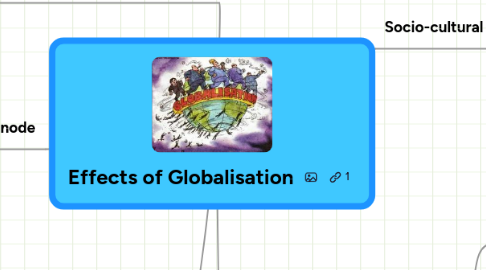
1. Economic health
1.1. Growth
1.1.1. +ve
1.1.1.1. Expanded markets
1.1.1.2. FDI
1.1.1.3. Cost savings
1.1.2. -ve
1.1.2.1. Contagion effects
1.2. Employment
1.2.1. +ve
1.2.1.1. Export oriented industries
1.2.1.2. Outsourcing
1.2.2. -ve
1.2.2.1. Structural unemployment
1.2.2.2. Outsourcing
1.3. Inflation
1.3.1. +ve
1.3.1.1. Cheaper imports
1.3.2. -ve
1.3.2.1. Demand/supply shocks
1.4. Balance of Payment
1.4.1. +ve
1.4.1.1. FDI --> improve financial a/c
1.4.1.2. Trade --> improve current a/c
1.4.2. -ve
1.4.2.1. Reverse contagion
1.4.2.2. Unfair trading practices
2. Environmental Impact
2.1. Ecology - disturbs the , upsets natural habitats
2.2. GLobal Warming - burning of fossil fuels
2.3. Blue Revolution - Rearing of fish for consumption , because of rapid depletion due to mass fishing
2.4. Deforestation - mass felling of trees
2.5. Rise of Eco-Tourism - for conservation & educational purposes, eg: Taman Negara nature reserve in Malaysia
2.6. Some current solutions: Renewable Energy, building of more environmentally friendly buildings, conservation efforts
3. New node
4. Political Impacts
4.1. Positive
4.1.1. New political ideologies introduced
4.1.2. Tyrannical or incapable governments kept in check.
4.1.2.1. E.g. The downfall of the Manchu government in 1911.
4.1.3. Improve international relations between countries.
4.1.3.1. E.g. The formation of interest groups like the WTO, Shanghai Cooperation Organization and NATO.
4.2. Negative
4.2.1. May cause socio-political instability
4.2.1.1. E.g. The spread of the Jasmine Revolution in the Middle East.
4.2.2. Radical ideas may become widespread.
4.2.2.1. E.g. The spread of Communism during the Cold War.
4.2.3. Conflicts may arise between nations due to differences in ideas and agendas.
4.2.3.1. E.g. Sino-American trade disputes
5. Socio-cultural
5.1. Positive
5.1.1. cultural exchanges/preservation/heterogeneity
5.1.1.1. E.g. Chinese wave, J wave and K wave, not solely about westernisation
5.1.2. Propagation of democratic principles and civil liberties
5.1.2.1. E.g. Clamour of freedom across repressive regimes in the Arab world; China perhaps according more respect to basic rights
5.1.3. Online community of like-minded individuals
5.1.3.1. Foster bonds across geo boundaries
5.1.3.2. Effect positive social changes
5.1.3.2.1. Fundraising for a devastated Japan
5.2. Negative
5.2.1. erosion of native culture
5.2.2. McDonaldisation of society
5.2.2.1. homogenisation
5.2.3. deterioration of social values
5.2.3.1. e.g. less respect for the elderly in India
